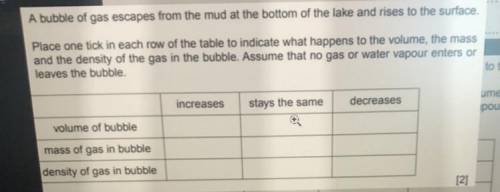
Physics, 05.01.2021 09:10 goldenhawk239
A bubble of gas escapes from the mud at the bottom of the lake and rises to the surface. Place one tick in each row of the table to indicate what happens to the volume, the mass and the density of the gas in the bubble. Assume that no gas or water vapor enters or leaves the bubble.


Answers: 2


Other questions on the subject: Physics

Physics, 22.06.2019 02:00, llamasking
Chapter 23, problem 075 the figure shows a geiger counter, a device used to detect ionizing radiation (radiation that causes ionization of atoms). the counter consists of a thin, positively charged central wire surrounded by a concentric, circular, conducting cylindrical shell with an equal negative charge. thus, a strong radial electric field is set up inside the shell. the shell contains a low-pressure inert gas. a particle of radiation entering the device through the shell wall ionizes a few of the gas atoms. the resulting free electrons (e) are drawn to the positive wire. however, the electric field is so intense that, between collisions with gas atoms, the free electrons gain energy sufficient to ionize these atoms also. more free electrons are thereby created, and the process is repeated until the electrons reach the wire. the resulting "avalanche" of electrons is collected by the wire, generating a signal that is used to record the passage of the original particle of radiation. suppose the radius of the central wire is 24 âµm, the inner radius of the shell 2.3 cm, and the length of the shell 14 cm. if the electric field at the shell's inner wall is 2.8 ă— 104 n/c, what is the total positive charge on the central wire?
Answers: 1

Physics, 22.06.2019 14:30, 21schraderlily
Will mark as brainliest how does a catapult increase the trajectory of an object? ps. answer as if u were a 5th grader
Answers: 1

Physics, 22.06.2019 15:50, potatocow
The california mussel (mytilus californianus) attaches itself to a rock or other solid surface with a bundle of filaments known as the byssus. imagine that 15.0 j of work is done to stretch the distal end of the byssus. it releases 10.8 j of thermal energy as it relaxes. what is the resilience of the distal end of the byssus?
Answers: 2

Physics, 22.06.2019 21:30, katwright1124
Atoaster oven has a resistive heating element. the average rate at which it dissipates energy as thermal energy is 1.00 \(\rm kw\). in the united states, emf amplitude in household circuits is \(\mathcal e_{\max}\) = 170 \({\rm \; v}\) and the \(\rm ac\) oscillation rate is 60 \(\rm hz\). part a what is the root-mean-square current through the heating element?
Answers: 2
You know the right answer?
A bubble of gas escapes from the mud at the bottom of the lake and rises to the surface. Place one t...
Questions in other subjects:












